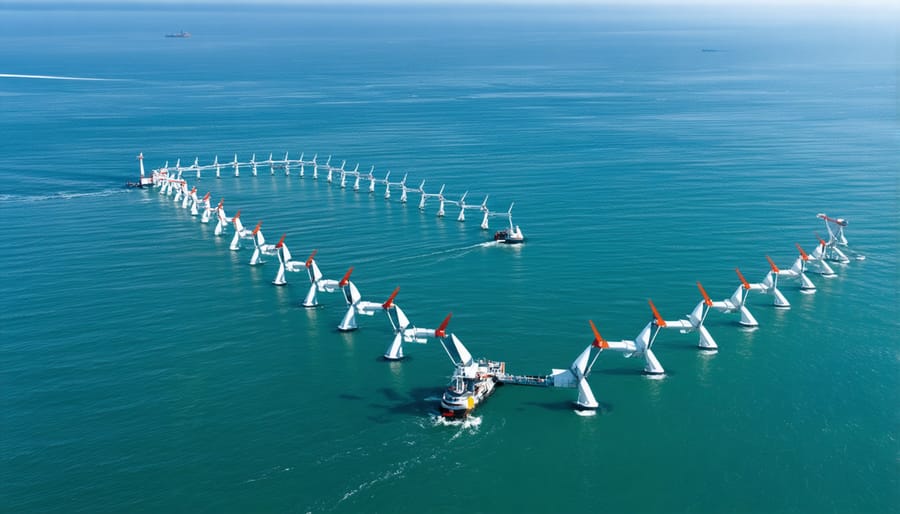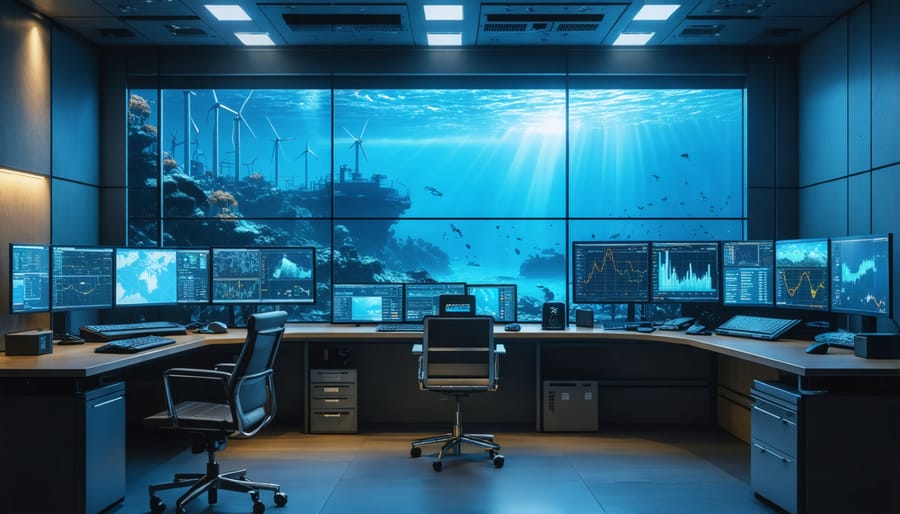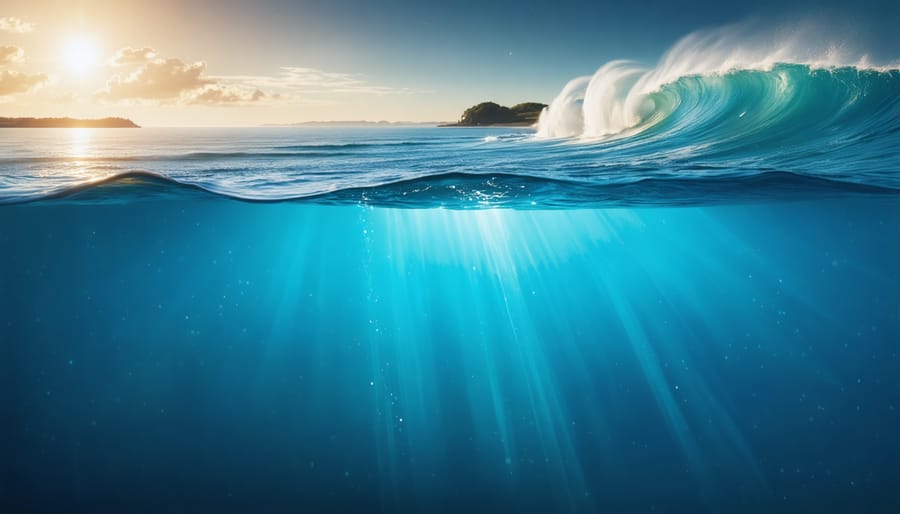As powerful waves crash against Australia’s vast coastline, they carry more than just water – they transport enough untapped energy to power millions of homes. The evolution of Australia’s renewable energy landscape now turns to our oceans, where innovative technologies are transforming these rhythmic swells into sustainable power.
Ocean energy management represents a critical frontier in our transition to renewable resources, offering consistent and predictable power generation through tidal forces, wave motion, and thermal gradients. Unlike intermittent solar or wind power, ocean energy provides reliable baseload power, operating 24 hours a day, 365 days a year.
Along Australia’s 37,000-kilometer coastline, strategic placement of wave energy converters and tidal turbines could generate up to 40% of the nation’s energy needs by 2050. This emerging sector not only promises clean energy production but also creates thousands of jobs in coastal communities while protecting marine ecosystems through careful environmental stewardship.
As global leaders in marine technology and environmental conservation, Australia stands uniquely positioned to harness this blue energy revolution, turning our greatest natural asset into a sustainable power source for future generations.
The Power Beneath the Waves
Tidal Energy Systems
Tidal energy systems harness the predictable power of ocean tides to generate clean, renewable electricity. Along Australia’s vast coastline, these systems tap into the natural ebb and flow of tidal movements, converting kinetic energy into electrical power through sophisticated turbine technology.
The most common type is the tidal barrage system, which operates like a traditional hydroelectric dam but uses tidal movements instead of river flow. When tides rise, water flows through turbines into a basin, generating electricity. During low tide, the water is released back to the ocean, creating a second generation opportunity.
Tidal stream generators offer another promising approach, particularly suited to Australia’s coastal conditions. These underwater turbines work similarly to wind turbines, using tidal currents rather than wind to spin their blades. The Kimberley region in Western Australia, with its impressive tidal range of up to 11 metres, presents exceptional potential for such systems.
Recent innovations include dynamic tidal power arrays and tidal kite technology, which can generate power in areas with lower tidal ranges. These developments are making tidal energy increasingly viable for coastal communities across the country. The Derby tidal power project in Western Australia showcases how these systems can provide reliable renewable energy while supporting local grid stability.
Importantly, tidal energy systems offer predictable power generation patterns, unlike some other renewable sources, making them valuable for baseload power supply. This reliability, combined with minimal visual impact and long operational lifespans, positions tidal energy as a crucial component of Australia’s renewable energy future.

Wave Energy Converters
Wave energy converters (WECs) are transforming how we harness the ocean’s powerful kinetic energy, offering a promising solution for Australia’s renewable energy future. These innovative devices capture the energy from ocean surface waves and convert it into electricity, providing a reliable and consistent power source.
Several types of WECs are currently making waves in the industry. Point absorbers, which resemble large buoys, move up and down with the waves to generate power. Oscillating water columns create electricity by forcing air through turbines as waves rise and fall within partially submerged structures. Overtopping devices channel waves into elevated reservoirs, using the stored water to drive turbines as it flows back to sea level.
Australia’s southern coastline, particularly in Victoria and Tasmania, offers ideal conditions for wave energy harvesting. The CETO system, developed by Carnegie Clean Energy in Western Australia, stands out as a pioneering achievement. This fully submerged technology operates underwater, making it more resistant to extreme weather conditions while minimizing visual impact on coastal landscapes.
Recent implementations have shown promising results, with pilot projects demonstrating the potential for wave energy to power coastal communities. The Garden Island project in Western Australia successfully integrated wave energy with the local power grid, providing both electricity and desalinated water to nearby facilities.
As technology advances and costs decrease, wave energy converters are becoming increasingly viable for large-scale deployment along Australia’s extensive coastline, offering a sustainable solution for our energy needs.
Smart Management Systems

Grid Integration Solutions
Connecting ocean energy systems to existing power grids presents unique challenges and opportunities for Australia’s renewable energy future. The key to successful integration lies in developing robust infrastructure that can handle the variable nature of ocean energy while maintaining grid stability.
Modern grid integration solutions employ sophisticated power electronics and energy storage solutions to smooth out power delivery. Smart inverters play a crucial role by converting the variable DC power generated by ocean devices into grid-compatible AC power, while also providing essential grid support services like voltage regulation and frequency control.
The Albany Wave Energy Project in Western Australia showcases effective grid integration practices, utilizing a combination of advanced power conditioning systems and underwater substations. These substations act as collection points for multiple wave energy converters, streamlining the power transmission process before connecting to the mainland grid.
To ensure seamless integration, developers are implementing adaptive grid management systems that can predict and respond to changes in ocean energy production. These systems use real-time monitoring and artificial intelligence to optimize power flow, reducing strain on the grid during peak generation periods.
Australian grid operators are also adopting hybrid approaches, combining ocean energy with other renewable sources to create more reliable power networks. By pairing wave or tidal energy with wind or solar power, operators can better match energy supply with demand patterns, making ocean energy a more attractive option for utilities and energy retailers.
The success of these integration efforts demonstrates that ocean energy can be a dependable contributor to Australia’s energy mix, providing clean, renewable power while supporting grid stability and reliability.
Monitoring and Maintenance
Regular monitoring and maintenance are crucial for ensuring the optimal performance and longevity of ocean energy systems. Modern facilities employ a combination of remote sensing technologies, autonomous underwater vehicles (AUVs), and AI-powered grid management systems to keep operations running smoothly.
Real-time monitoring systems track wave patterns, equipment performance, and environmental conditions. Smart sensors attached to turbines and wave energy converters continuously gather data about structural integrity, power output, and potential wear and tear. This proactive approach helps operators identify and address issues before they become critical.
Maritime conditions pose unique challenges for maintenance crews. To address this, many Australian facilities have adopted innovative solutions like robotic maintenance systems and specialised vessels designed for rough ocean conditions. These purpose-built vessels can safely transport technicians and equipment even in challenging weather.
Preventive maintenance schedules are carefully planned around seasonal weather patterns, particularly considering Australia’s cyclone season. Operators typically schedule major maintenance works during calmer months to ensure worker safety and minimise downtime.
Corrosion management is another critical aspect, given the harsh marine environment. Advanced materials and protective coatings help extend equipment life, while regular inspections check for signs of deterioration. Biofouling prevention systems protect underwater components from marine growth that could affect performance.
Local maintenance crews receive specialised training in marine operations and safety protocols. Many facilities maintain partnerships with nearby ports and marine service providers to ensure rapid response capabilities when urgent repairs are needed. This comprehensive approach to monitoring and maintenance helps maximise the reliability of ocean energy systems while protecting our marine environment.
Environmental Considerations
Marine Ecosystem Protection
Australia’s commitment to marine ecosystem protection while harnessing ocean energy has become a global benchmark for sustainable development. The integration of advanced monitoring systems and careful planning ensures that marine renewable projects coexist harmoniously with ocean life.
Key protective measures include establishing exclusion zones during migration seasons and implementing noise reduction technologies during construction phases. These strategies have proven particularly effective in safeguarding whale populations along the southern coast, where several pilot projects operate successfully alongside marine sanctuaries.
Environmental impact assessments are conducted regularly, with special attention paid to seabed habitats and fish breeding grounds. Innovative designs, such as fish-friendly turbines and marine-life detection systems, have significantly reduced the risk to marine species. These technologies automatically adjust operations when large marine animals are detected nearby.
Local indigenous communities contribute valuable traditional knowledge about marine ecosystems, helping developers identify sensitive areas and seasonal patterns in marine life behaviour. This collaborative approach has led to better project placement and timing decisions.
Australian marine energy projects also incorporate artificial reef structures into their designs, creating new habitats for marine life. These structures have shown promising results, with increased biodiversity reported around several installations. Regular monitoring shows that some species have actually benefited from these modifications, turning energy infrastructure into thriving marine ecosystems.
Sustainable Installation Practices
Installing ocean energy systems requires careful planning and execution to ensure both environmental protection and optimal performance. The process begins with comprehensive site assessments, where factors like wave patterns, tidal flows, and seabed composition are thoroughly evaluated. These assessments help determine the most suitable locations while minimizing impact on marine ecosystems.
Best practices include using environmentally friendly materials that resist corrosion and marine growth without leaching harmful chemicals into the water. Installation teams now employ noise reduction techniques during construction to protect marine mammals and fish populations. This includes using bubble curtains and scheduling work around marine wildlife migration patterns.
The use of dynamic positioning vessels has revolutionized installation procedures, allowing for precise placement of equipment while minimizing seabed disturbance. These vessels use GPS and computer-controlled systems to maintain position without anchoring, significantly reducing damage to the ocean floor.
Modular design approaches have become standard practice, allowing for easier maintenance and reduced installation time. Components are assembled as much as possible on land, minimizing offshore construction work and associated environmental risks. This approach also makes future upgrades and repairs more manageable.
Installation teams now work closely with marine biologists and environmental experts throughout the process. This collaboration ensures that installation methods adapt to local environmental conditions and protect sensitive marine habitats. Regular monitoring during installation helps verify that environmental safeguards are working effectively.

The Australian Advantage
Australia’s vast coastline, stretching over 35,000 kilometers, positions the nation uniquely to harness the immense potential of ocean energy. With some of the world’s most powerful waves along its southern shores and significant tidal movements in the north, Australia possesses natural advantages that few other countries can match.
The combination of advanced maritime infrastructure, world-class research institutions, and established expertise in offshore industries creates a solid foundation for ocean energy development. Cities like Perth, Adelaide, and Darwin are strategically located to become hubs for marine energy innovation, with their proximity to optimal ocean energy sites and existing port facilities.
What sets Australia apart is not just its physical attributes, but also its comprehensive approach to renewable energy integration. The nation’s experience in managing large-scale energy projects, particularly in remote coastal areas, provides valuable insights for ocean energy implementation.
The Great Southern Ocean offers consistent wave patterns that could power coastal communities year-round, while the tropical north’s tidal ranges present opportunities for predictable energy generation. These natural assets, combined with Australia’s strong environmental protection framework, ensure sustainable development of ocean energy resources.
Furthermore, Australia’s established relationships with Asia-Pacific markets position it perfectly to become a leader in ocean energy technology export. The expertise gained from managing complex marine environments through industries like offshore oil and gas can be effectively transferred to ocean energy projects.
Local communities along the coastline also stand to benefit from ocean energy development, with potential for new jobs, improved energy security, and economic diversification. This alignment of natural resources, technical capability, and community interest creates a powerful advantage for Australia in the emerging ocean energy sector.
Australia stands at the cusp of an exciting energy revolution, with ocean energy management poised to play a pivotal role in our renewable future. The vast coastline that defines our nation presents an unprecedented opportunity to harness the power of waves, tides, and currents. As successful pilot projects in places like Garden Island and Port Kembla demonstrate, we have the expertise and technology to make ocean energy a significant contributor to our energy mix.
Looking ahead, the pathway to widespread ocean energy adoption requires a coordinated effort between government, industry, and communities. Key priorities include streamlining permit processes, increasing investment in research and development, and establishing more demonstration sites along our coastline. The Australian Renewable Energy Agency’s commitment to funding innovative marine energy projects signals strong governmental support for this emerging sector.
The future of ocean energy in Australia is particularly promising when considered alongside our existing renewable infrastructure. By integrating ocean energy with solar, wind, and battery storage systems, we can create a more resilient and reliable energy network. This comprehensive approach to energy management will not only help meet our climate commitments but also create thousands of new jobs in coastal communities.
To realise this potential, we must maintain our momentum in technological innovation while ensuring environmental protection remains at the forefront of development. With continued collaboration and commitment, Australia can become a global leader in ocean energy management, setting standards for sustainable marine energy practices worldwide.

